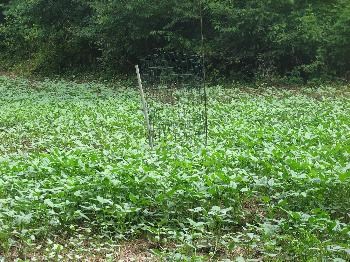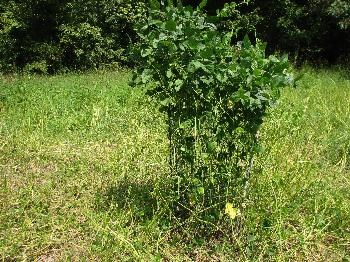Exclosure Cages in Food Plots
Have you ever wondered how much forage your food plot is producing or to what extent wildlife utilize your plot? There is a simple and inexpensive way to get good answers to these questions. Placing at least one exclosure cage in each of your food plots will demonstrate forage rate of growth and the amount of wildlife usage. An exclosure restricts wildlife access from a small area within the plot, allowing plants to demonstrate how well they grow on each site without the impact of wildlife.
 Construction and Placement:
Construction and Placement:
Constructing an exclosure is simple. Cut a piece of wire mesh small enough to prevent rabbits from entering (e.g., 1" x 2") and form a circular or square area at least three feet across and four feet tall. After the plot is planted, stand the exclosure up and secure it with stakes on at least two sides so that it cannot be pushed around by foraging animals, such as deer or feral hogs.
The use of metal stakes such as concrete reinforcement rods (re-bar) is suggested. The exclosure should be placed in a representative area of the plot avoiding the highest or lowest points, wettest or driest points, or the most or least fertile areas. Placing the exclosure towards the middle of the plot will eliminate competition effects from native vegetation around plot edges, especially trees. Be careful to not place cages where excessive seed or fertilizer was spread or spilled. If you wait until the seed has sprouted and emerged, pick an area representative of the food plot to place the exclosure. Make sure the exclosure is in place as soon as possible after planting to eliminate bias from early use by wildlife.

Record Keeping:
Records should be kept for future reference as to the growth rate and utilization in plots with exclosures. For each plot, the most basic records of liming, fertilization, soil preparation method, seed rate, and plant species (including variety) should be documented initially. The exact planting date should be recorded along with any pertinent information about soil or weather conditions.
Each plot with an exclosure should be observed periodically, at least once every 2 - 3 weeks, and notes taken at time of observation. These notes should address weather conditions since the last observation documenting amount of rainfall, temperature extremes, and other weather phenomena. Notes should also be made on food plot use by different wildlife species such as rabbit, turkey, deer, and hogs by track observation, sightings, or fecal droppings.
At each observation period, the height of the planted species inside and outside the exclosure should be measured. For the height outside the exclosure, take several measurements throughout the plot and use the average. Documentary photographs can also be taken. Take at least one photo of the exclosure with a yard stick or measuring tape placed firmly on the ground and extending upward along the outside of the exclosure. Be sure to include some of the area outside the exclosure and focus the camera so that measurement increments (inches) can be seen on the photo. Take another photo of the entire plot with the exclosure in view. Make sure that both photos are dated and taken from the same location each time.
Summary:
Evaluating food plot growth and utilization can save time and money and provide more supplemental food for wildlife.
After reviewing the data collected in plots with exclosure cages, you should be able to determine:
- Which plant species performs best on specific sites?
- What time of year each forage species is available?
- Impact of weather extremes on plant growth.
- Which plant species are utilized the most by wildlife?
With this information, managers can make more informed decisions about food plot management.









